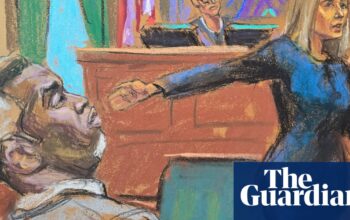T
72 Films, a production company, focuses on creating “box set” documentaries according to executive producer Rob Coldstream. These documentaries delve deep into archives to explore intriguing figures, events, or moments in history while also making a statement about the world. Some of their past subjects have included Donald Trump, Elon Musk, and Bashar al-Assad. However, their most recent project, a three-part miniseries called “John Lennon: Murder Without a Trial”, available on Apple TV, presented a new challenge due to its apparent simplicity.
There is no uncertainty surrounding the murder of the famous musician and symbol of counterculture by Mark David Chapman. Numerous witnesses observed it occur in front of the Dakota apartments, Chapman was quickly caught, and his admission of guilt resulted in a 20-year-to-life sentence at the Green Haven correctional facility, where he remains today. The co-directors, Coldstream and Nick Holt, believed that they could explore the topic in a unique way by focusing on the details rather than the overall scope, closely examining the already established elements of a notorious case with assistance from those involved.
According to Coldstream at his London office, there have been numerous shows exploring different aspects of John’s death and Mark David Chapman. However, none have presented a comprehensive and definitive account free from any bias. The goal was not to sensationalize or entertain, but rather to lay out the facts. Upon further investigation, it became clear that there were significant gaps in the information and discussions surrounding Chapman’s mental state that had not been given much attention. As a result, the team began researching and discovered individuals who had not previously shared their insights on the matter.
Instead of examining one of the most extensively studied public figures of the 20th century, the three parts of the series shift their focus away from Lennon and instead create a highly detailed portrait of Chapman. His perplexing motivations both intrigued and confounded Coldstream. Through years of research and two years of production, their team consulted with legal representatives from both sides, investigators, psychiatrists, and a few individuals present at the time to try to understand the senseless tragedy that still mystifies countless fans. Lennon’s vocal advocacy for peace adds another layer of confusion to the violent act that took his life, an enigma that Coldstream uses as a starting point.
Coldstream describes the central conflict of the story as the struggle to piece together clues and understand Chapman’s motives. The goal was to present an objective account of the facts from both the prosecution and defense, without adding unnecessary drama. The fact that Chapman was the perpetrator of the crime was not a mystery. The real questions were what motivated him to commit such an act and how the justice system would handle his case.
Following the tragic shooting in 1980, there was a widespread desire to gain a deeper understanding of the event. Many people turned to a narrative of an angry young man, similar to a creation myth, to explain the motivation behind the shooting. The shooter, Chapman, was often compared to the character of Holden Caulfield from The Catcher in the Rye, portraying him as a disillusioned and alienated individual who was resentful of John Lennon’s hypocritical actions. Chapman’s delusions and mental disturbances were seen as the driving force behind his actions, as he was unable to cope with the disappointments of the adult world and instead projected his torment onto others. This perspective is also reflected in Jared Leto’s portrayal of Chapman in the film Chapter 27, which Coldstream describes as “quite good”.
Using traditional methods such as cold calling and personal research, Coldstream managed to uncover individuals who had a deeper understanding of Chapman’s mindset, notably lawyer David Suggs. Suggs tried to convince his client to use an insanity defense as a final attempt to avoid imprisonment. Chapman initially seemed willing to go along with this plan, but ultimately surprised everyone by confessing to being fully aware of his actions and accepting his punishment.
Suggs discusses the significance of culpability and remorse with Chapman, two ideas that were highlighted by a character witness that Suggs’ team found many years ago. The most insightful viewpoint comes from Chapman’s childhood friend Vance Hunter, who remembered the physical and verbal abuse that Chapman endured from his father. Hunter connects the impact of this intense emotional pressure to Chapman’s later experimentation with psychedelics, conversion to Christianity, and eventual act of murder.

“I approached this project with an open mind,” says Coldstream. “I had limited knowledge about [Chapman] initially. It was fascinating to gather firsthand perspectives from law enforcement and psychiatrists and see their reactions. However, it wasn’t until we spoke to his childhood friends that he became a multidimensional person to me. Our goal was not to create a film to redeem Mark David Chapman. We do not believe there was an injustice in his case. Rather, I am more interested in exploring empathy and understanding. Through this, we can start to comprehend the elements that may have contributed to his mental health struggles.”
Despite dealing with indisputable facts, Coldstream was faced with the challenge of how to portray a universally despised villain. In order to balance sensitivity and accountability, he presents multiple perspectives to showcase the pain that Chapman both held onto and inflicted. One clip shows a devastated fan in denial at the Dakota, stuttering that Lennon would never leave them, with a wavering certainty akin to those awaiting the second coming of Christ. The documentary also delves into the more bizarre consequences of this fanatical admiration, such as conspiracy theories alleging that CIA handlers used drugs to manipulate Chapman into killing Lennon. Perhaps the most touching moment is an interview with Lennon’s son, Sean, who simply knew his father as “Dad”.
The creator of Coldstream acknowledges that for those under 40, the events being discussed may seem like ancient history. Even his own children only have a limited understanding of the Beatles. However, the generation that popularized the idea of the parasocial relationship should have no difficulty understanding how people from all walks of life projected their own values onto the person they believed in and were inspired by. This concept is presented as the closest thing to an explanation for the unanswerable question of why Chapman felt so personally betrayed. The series ends with Sean expressing his grief, giving a poignant sense of mourning to Coldstream’s approach – not excusing or condemning Chapman, but conveying sadness that he had to endure such suffering and had no other outlet for his inner turmoil.
“When one hears [Chapman] trying to make sense of himself and his actions while in prison, there is a natural inclination towards sympathy,” Coldstream explains. “However, it is important to recognize that he has committed a terrible act, and as filmmakers, we had a responsibility to portray that fact.” Despite the controversy surrounding Lennon’s death, one of his fans eloquently expresses that his life was centered around peace. When it comes to the debate of forgiveness versus retribution, it is clear which side John would have been on.”
-
John Lennon’s documentary, “Murder Without a Trial,” will be released on Apple TV+ on December 6th.
Source: theguardian.com


